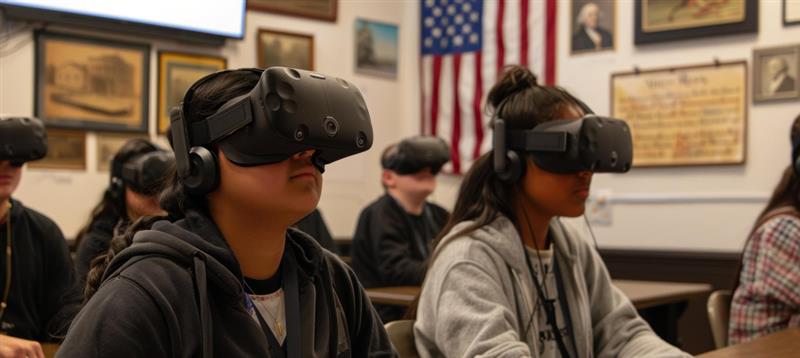Dan Schwartz, dean of Stanford Graduate School of Education (GSE) quoted “Technology is a game-changer for education – it offers the prospect of universal access to high-quality learning experiences, and it creates fundamentally new ways of teaching.”
Source: https://news.stanford.edu/stories/2024/02/technology-in-education
The educational landscape is constantly evolving. Modern-day educators need to embrace the power of technology to keep up with the future education trends and technologies.
According to a research report, the global EdTech market size was estimated at 142.37 billion USD in 2023 and is expected to grow at a CAGR of 13.4% from 2024 to 2030.
Immersive technologies like augmented reality, virtual reality (VR), and mixed reality are expected to be used in classrooms with the release of many high-profile devices in the near future.
Personalized learning is the need of the hour as it enables educators to generate content aligned with students’ interests and skill levels. It also makes lessons more accessible for multilingual learners and students with disabilities. All this requires educators who are well-versed in the latest educational tools and technologies.
But with numerous educational apps and tools available, where do you even begin? Not to worry! This blog will guide you through the benefits of integrating technology into your classroom and explore some of the best tools and apps to make your teaching job easier and effective.
What are the Benefits of Using Technology as a Tool in the Classroom?
Technology can benefit educators in many ways such as:
- Enhanced Student Engagement
- Personalized Learning
- Efficient Assessments & Feedback
- Access to Diverse Resources
- Collaborative Learning
- Streamlined Admin Tasks
- Data-driven Insights
- Flexible Learning
- Professional Development
Here are just a few reasons why incorporating educational technology can be a game-changer for both educators and students:
- Enhanced Engagement: Educational technology can make learning more interactive and engaging through multimedia content, gamification, and interactive simulations, capturing students’ interest more effectively than traditional methods.
- Personalized Learning: Technology allows for adaptive learning platforms that cater to individual students’ needs and learning paces, providing tailored resources and assessments to help each student succeed.
- Efficient Assessment & Feedback: Tools such as digital quizzes and automated grading systems enable educators to quickly assess student progress and provide instant feedback, saving time and enhancing the learning process.
- Access to Diverse Resources: Technology provides students with access to a wealth of online resources, including educational videos, interactive modules, and scholarly articles, broadening their learning materials beyond textbooks.
- Collaborative Learning Opportunities: Various learning platforms offer features like discussion boards, group chats, etc to facilitate teamwork and communication among students. Thus, technology tools can foster collaboration and teamwork.
- Streamlined Administrative Tasks: Technology simplifies a lot of daily tasks like attendance, lesson planning and routine interactions with parents. Educators can use technology for these tasks and focus more on teaching.
- Data-Driven Insights: Learning management systems (LMS) and educational apps often include analytics features that provide valuable insights into student performance and engagement. These insights help educators make informed decisions and take the right actions.
- Flexible Learning Environments: Technology supports both classroom learning and remote learning, offering great flexibility for learners and educators alike. This is beneficial in accommodating various learning preferences and situations.
- Professional Development: Thanks to technology, many educational institutes and universities are offering certification courses and online degree courses for teachers enabling them to acquire new skills and learn effective teaching techniques. Teachers can also join professional networks and attend webinars to follow industry updates.
Best Technology Tools and Apps for the Classroom
- ClassDojo
- Kahoot!
- Padlet
- Seesaw
- Google Classroom
- Flipgrid
- Socrative
- Edpuzzle
- Quizizz
Integrating technology into the classroom can significantly enhance both teaching and learning experiences. Here’s a look at some of the most innovative and effective classroom technology tools and apps:
ClassDojo: ClassDojo remains a favorite for fostering communication and community within the classroom. This app allows teachers to share updates, classroom activities, and student achievements with parents in real-time. Its intuitive platform also supports positive behavior reinforcement, helping to create a more engaged and motivated classroom environment.
Kahoot!: Kahoot! continues to be a dynamic tool for interactive learning. With its game-based quizzes and polls, it transforms assessments into engaging competitions. This approach not only makes learning fun but also encourages participation and instant feedback, which can be particularly useful for reinforcing concepts and gauging understanding.
Padlet: Padlet offers a versatile platform for collaboration and creativity. Teachers and students can create digital boards to share ideas, resources, and projects. Whether used for brainstorming sessions, group work, or reflective journals, Padlet’s user-friendly interface supports a range of interactive and collaborative activities.
Seesaw: Seesaw stands out for its student-driven portfolios and family engagement features. It enables students to document their learning process through photos, videos, and reflections. Parents can stay informed about their child’s progress and achievements, fostering a stronger home-school connection.
Google Classroom: Google Classroom remains a cornerstone of classroom technology. Its integration with Google Workspace tools facilitates streamlined assignment distribution, grading, and communication. The platform’s seamless integration with other Google services enhances productivity and organization for both teachers and students.
Flipgrid: Flipgrid provides a platform for video discussions and reflections, offering students a voice in a more personal format. Teachers can pose questions or topics, and students respond via video, promoting deeper engagement and enabling diverse forms of expression and feedback.
Socrative: For teachers looking to assess student understanding in real-time, Socrative is an excellent choice. This app allows for the creation of quizzes and polls that can be instantly graded. Its detailed reporting features help teachers track progress and identify areas needing additional focus.
Edpuzzle: Edpuzzle turns video lessons into interactive experiences. Teachers can embed questions and prompts within educational videos, making passive viewing more engaging and ensuring that students stay focused and understand the material.
Quizizz: Quizizz provides a gamified approach to assessments. Its live and homework modes allow for flexible use, and real-time feedback helps students and teachers gauge understanding immediately. The app’s extensive library of pre-made quizzes covers a wide range of subjects and grade levels.
Tips to Choose the Right EdTech Tools for the Classroom
With so many options, choosing the right EdTech tools can feel daunting. Here are some tips to consider:
- Learning Objectives: Ensure the chosen tool aligns with your curriculum goals and learning objectives.
- Student Needs: Consider the age group of your students, their learning styles, and any other specific needs while choosing a tool.
- Ease of Use: Choose educational tools that are easy to navigate for both you and your students.
- Cost and Time Commitment: Consider the costs associated with tools, as well as the time required for set-up and implementation.
- Free Trials and Resources: Check out the free trials or versions offered by various educational technology platforms to get started.
Embrace the Potential of EdTech
Technology is a powerful tool, but it’s important to remember that it shouldn’t replace traditional teaching methods. EdTech should be used to enhance lessons, not replace them.
To explore more about how technology can transform your teaching practice, and to advance your teaching career, check out the courses offered by Acacia University’s School of Education. Embrace the power of technology and take your educational practices to the next level.
Our programs offer a strong foundation in educational technology integration, preparing future educators to thrive in the modern classroom.









